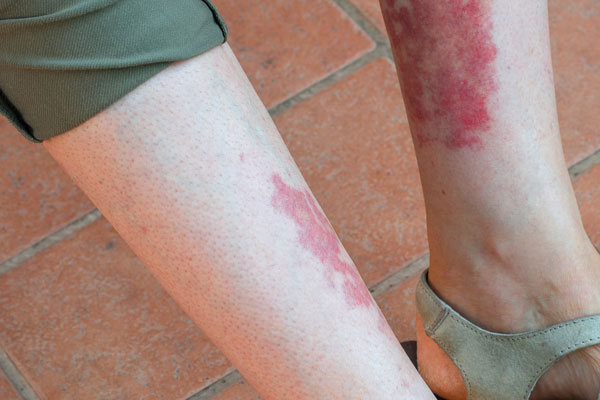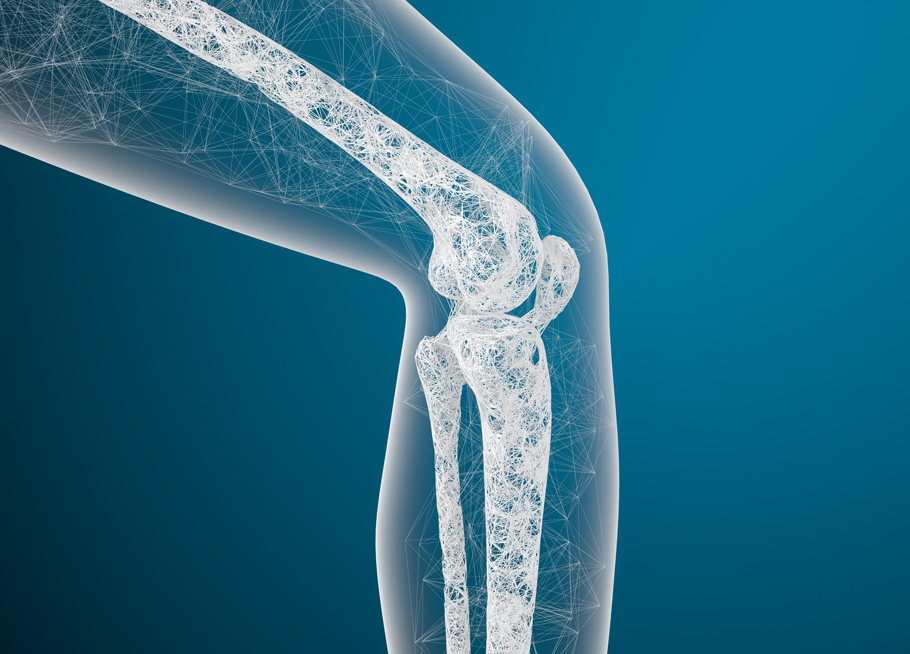
Vasculitis is a general term used to describe a disease that leads to inflammation of blood vessels. When the blood vessels of your legs become inflamed, this is called vasculitis of the legs.
The blood vessels in your legs start to weaken and can either grow or shrink in size. When a blood vessel shrinks, it can narrow to a point where it can entirely close off. A patient may show various symptoms according to the severity of the condition.
What does vasculitis look like on legs?
The most common symptoms of vasculitis show as red or purple dots on the skin called petechiae. They can appear in large numbers on the legs. You can develop larger red or purple spots around the size of a fingertip. Larger spots are called purpura.
Larger spots (purpura) can often look like bruises on the skin, but the patient hasn’t knowingly knocked or injured the leg to result in a bruise. Unlike a bruise, purpura doesn’t fade or disappear after a few days.
While petechiae and purpura are the most common symptoms of vasculitis in the legs, a less common form of vasculitis is where your legs develop hives. This is where the skin on your legs develops itchy raised lumps that can be tender and painful to the touch.
A few conditions mimic the symptoms of vasculitis in the legs. Your doctor may perform a skin biopsy to either confirm or rule out other conditions, including urticarial lesions, nodules, ulcers, livedo reticularis, and livedo racemosa.
What causes vasculitis in the lower legs?
In most cases, the cause of vasculitis in the lower legs is unknown. The condition is an inflammation of the blood vessels in the legs, and it occurs when your body’s immune system attacks the blood vessels by mistake.
Developing vasculitis in the legs can happen after experiencing an infection, virus, disease or a side effect from taking medications to treat a health condition. There is no common link that can trigger the condition.
Doctors can trace back the cause to many different possible triggers, especially a viral-related cause or allergic reaction to prescription medications. This is because viruses or infections can trigger your immune system negatively, causing it to overreact and attack the healthy blood vessels in your legs.
Your immune system can also overact and create a build-up of blood cells that block the narrow blood vessels in your legs, leading to inflammation and vasculitis. If you already have a weak immune system, you can develop vasculitis in any part of the body. But when vasculitis develops in your legs, the blood vessels become inflamed and can become thicker or narrower.
How do you diagnose vasculitis in the legs?
Your doctor will usually take a blood sample to analyse. This will be screened for other possible diseases or infections that could cause your symptoms. Depending on how severe your symptoms are when presenting to your doctor, they may order several functional tests to check your organ functions.
You will have a biopsy where your doctor will take a sample of tissue and bodily fluid from an affected area of your leg. This will be tested for inflammatory markers to give you a proper diagnosis of vasculitis.
Your doctor may also take an x-ray test or angiogram of the blood vessels in your legs to check for any inflammatory pattern in the blood vessels.
How is vasculitis of the leg treated?
The treatment for vasculitis of the legs will depend on the severity of the condition and your individual diagnosis. It is a serious health condition that often requires professional medical treatment and support to control and manage the condition long term.
If your doctor finds that the cause of the vasculitis is an immune response, then your treatment could involve prescription medication that helps suppress your immune system.
Vasculitis of the legs caused by an allergic reaction from taking medications may subside on its own without needing any other medical intervention.
However, in some cases, medical treatment may be necessary to help you manage the symptoms, especially if you are undergoing any ongoing therapies for cancer or another health condition where the medication you are reacting to is necessary.
How does the treatment work?
The treatments offered for vasculitis of the legs aim to control the inflammation causing the problem and manage any underlying issues that may cause the vasculitis.
Your doctor may prescribe a corticosteroid drug, which is the most common type of drug prescribed to control the inflammation associated with vasculitis. You may also be prescribed other medications to take with corticosteroids to help control and reduce the level of inflammation in your blood vessels. The medicines and dosage will depend on the type and level of vasculitis present.
Your medical team will closely monitor you to ensure that the medications you are prescribed are not causing any serious side effects or are proving ineffective. You may need long term medical support for your condition, so it is essential to keep your doctor informed of any changes and never ignore any worsening symptoms.
Will I need surgery?
In some cases of vasculitis of the legs, a patient may suffer from an aneurysm. This is where the wall of a blood vessel in the leg can swell or balloon out of shape and is at risk of rupturing.
When an aneurysm is detected, your doctor may refer you for surgery to reduce the risk of it rupturing.
Taking care of yourself
You must take good care of yourself while receiving treatment for vasculitis of the legs and in your everyday life. Eating healthily and taking regular gentle exercise can help to boost the blood flow to your legs, strengthen your immune system and tone up your leg muscles.
Walking, swimming, yoga, tai-chi and pilates are all excellent low-impact exercises that you can take up to help strengthen the muscles in your legs, improve blood flow, support the lymphatic system, and lower inflammation.
Try to avoid consuming inflammatory food and drink such as alcohol, sugary drinks, fruit juices etc. Eat low inflammation single-ingredient foods, and steer clear of processed packaged foods with long ingredient lists that contain sugar, grains and seed oils.
What is urticarial vasculitis?
Urticaria is a type of inflammation that involves a raised itchy rash appearing on the skin, more commonly known as hives. Symptoms can be short-lived and may disappear in a few hours.
However, repeated attacks and when symptoms last longer – even days or weeks, indicate that the blood vessels under the skin have become inflamed, a term known as urticarial vasculitis.
How rare is vasculitis?
Vasculitis is a rare disease that affects between two to three thousand new people in the UK each year. The term vasculitis is used to describe inflammation of the blood vessels in any part of the body. The inflammation limits blood supply to tissues and organs of the body.
Although vasculitis is a rare condition, we still don’t know the exact cause. However, early recognition and treatment of vasculitis can help reduce the often devastating effects the health condition can have on the body.
What is hsp vasculitis?
HSP stands for Henoch-Schönlein purpura. It is a health condition where there is inflammation of blood vessels. The cause of HSP is immunological and occurs when the white blood cells and antibodies in our blood start to attack our system by mistake.
Doctors still do not fully understand why this happens or what triggers the condition. It remains a rare condition that affects around five to ten people per million each year.
What is inflammatory vasculitis?
Inflammatory vasculitis diseases are categorised according to the predominant size of the blood vessel or arteries involved.
For example, the names of vasculitis conditions that affect large arteries are called:
- Giant Cell Arteritis/Temporal Arteritis
- Kawasaki Disease
- Polyarteritis Nodosa
- Polymyalgia Rheumatica
- Takayasu Arteritis
- Vasculitis mainly affecting middle-sized arteries
Diseases affecting the small blood vessels are divided into ANCA associated vasculitis and non-ANCA vasculitis.
ANCA-associated vasculitis is where a patient has one of three different vasculitis conditions:
- Eosinophilic Granulomatosis with polyangiitis
- Granulomatosis with polyangiitis
- Microscopic polyangiitis
These conditions are all associated with a protein factor carried in the blood called ‘ANCA’, and each disease causes inflammation to small blood vessels. This means that any part of the body can be affected because blood vessels are found all over the body.
ANCA associated vasculitis:
- Churg Strauss Syndrome, now renamed: Eosinophilic Granulomatosis with Polyangiitis
- Microscopic Polyangiitis
- Wegener’s Granulomatosis, now renamed: Granulomatosis with Polyangiitis
Non-ANCA vasculitis:
- Behçet’s Disease
- Buerger’s Disease
- Central Nervous System Vasculitis/Primary Angiitis of the Central Nervous System
- Cogan’s Syndrome
- Cryoglobulinemia and Cryoglobulinaemic Vasculitis
- Henoch-Schönlein Purpura
- Hypersensitivity Vasculitis
- Less common vasculitides
- Rheumatoid Arthritis (secondary vasculitis)
Article by Dr. Naveen Bhadauria



